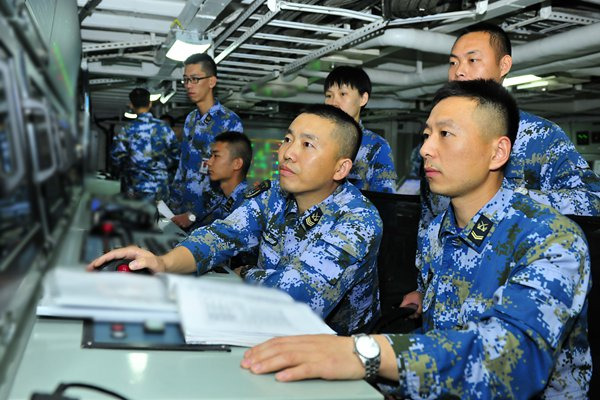
Huang Aijian (second from right), an officer with the electrical and mechanical squadron on the carrier, is on duty with his subordinates. (Photo/GT)
After thousands of tests and training missions, China's first aircraft carrier, the Liaoning, is combat ready. After four years, the crew of the Liaoning went from knowing virtually nothing about the vessel to achieving an astonishing series of firsts.
For an outsider, seeing the Liaoning, with a displacement of more than 60,000 tons, appear from out of the darkness is a truly stunning sight.
Before boarding the Liaoning, passengers first have to pass security checks and surrender their cell phones and lighters. A guide then leads visitors onto the carrier.
Compared with minesweepers with a displacement of a few hundred tons, or destroyers and frigates with a displacement of thousands of tons, the deck of the Liaoning is broader than a football field.
Aside from domestic visitors, experts including American military officers have already taken a close look at the carrier.
According to media reports, three U.S. senior officers and military commanders including the 24th Secretary of Defense Chuck Hagel, the 30th and the 31st Chiefs of Naval Operations Admiral Jonathan W. Greenert and Admiral John M. Richardson, set foot on the vessel during their visits to China.
Zhang Junshe, a senior researcher at the PLA Naval Military Studies Research Institute, believes that strengthening the Chinese and American military relationship will be good for minimizing conflicts and maintaining peace.
"We negotiate on what to show and what not to show during visits, usually the guest makes requests and respects the host's decision," Zhang told the Global Times. Both sides negotiate in advance about what military facilities or weapon equipment they will share.
The Liaoning up close
Aircraft carriers are a brand new business in China. In just a few years' time, the navy has developed a whole management system and is able to manage thousands of people's lives and training in an orderly manner, which wowed their American counterparts.
The orderly management can be seen in the details. Unlike destroyers and frigates, the Liaoning has lookouts at the entrance of the ladders to crew quarters. There is also a card reader, and crew members need to swipe their card when they leave and return to the Liaoning.
This is the crew members' "ID card" and it hangs on their chests. Their photo, name and department are all included on the card.
There is also a horizontal stripe made up of different colors and letters. The colors represent different departments and the letters represent the cabins they are allowed to enter. The department of aviation security is only entitled to visit two cabins for example.
On card of Li Dongyou, the political commissar of the Liaoning, there are eight colors and letters, which mean that he has an all-access-pass on the carrier. There is an inspection department supervising the enforcement of this rule.
In the mess hall, LED screens show rolling text of the working schedule and reminders for the day. In the place where the sailors return their plates, there are rules about leftovers, recyclables and nonrecyclables. Crew members have to fold their milk cartons flat before throwing them away.
There are more than 1,000 non-commissioned officers (NCOs) on the Liaoning. Among them, there are 42 senior NCOs, whose average age is 40 and they have all served in the military for more than 20 years.
"Senior non-commissioned officers are the hardcore. Their ability to use and maintain the equipment is irreplaceable and this is where our confidence lies," Li Dongyou told the Global Times.
There are more than 20,000 pieces of equipment on the Liaoning. The operation and maintenance manuals are all newly edited by the most experienced troops of the aircraft carrier force.
Zhang told the Global Times that the non-commissioned officer system is important in accelerating the military's construction and consolidating combat effectiveness.


















































